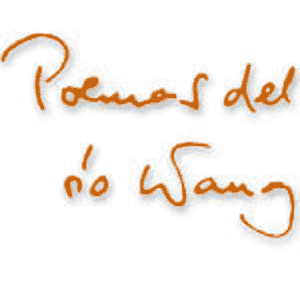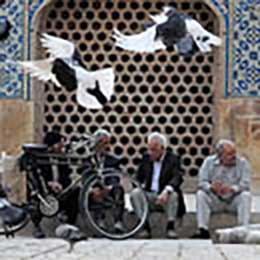Yesterday, I posted a few cheerful, naive animals from the desert companions of St. Anthony the Hermit on Facebook, from a 1418 altarpiece  at the Galleria Nazionale dell’Umbria in Perugia. Little ones, black ones, spiky ones, with big eyes and fiery red mouths. My Israeli Russian regular, Martin Lemke, shared the post with the comment: “Когда утром вышел на прогулку в Хайфе” – “When I go for a walk in Haifa in the morning.”
at the Galleria Nazionale dell’Umbria in Perugia. Little ones, black ones, spiky ones, with big eyes and fiery red mouths. My Israeli Russian regular, Martin Lemke, shared the post with the comment: “Когда утром вышел на прогулку в Хайфе” – “When I go for a walk in Haifa in the morning.”

At the end of the series, I also posted the full altarpiece. Since the composition is quite complex, you asked in the comments how the different elements come together, how the iconographic details respond to each other, how the composition takes shape, and how to "read" such an altarpiece.
Well, here’s how it works, more or less.
The altarpiece consists of two parts: an upper triptych and a lower predella. As the name suggests, the triptych is made up of three panels. Here in the North, we’re used to the idea of a triptych being a winged altarpiece, where the two side panels can be folded over the center. But that’s actually a later development from the late medieval Netherlandish tradition.
The very first Italian triptychs and polyptychs were inspired by the icon series of Palaeologan-era Byzantium, the most elegant trendsetting artistic center of the 14th-15th centuries. The Italians, too, wanted to line up their most important local saints the way the Byzantines did with their iconostasis, and these icons then grew to life size and merged into a single three- or multi-paneled altarpiece. Each panel depicted a saint, just like Byzantine icons. It would be a later development for the Italians to begin perceiving the panels as a unified space, where the previously separate figures engage with each other and form a group, typically around the central figure, usually the Madonna. This style will later be known as the Sacra Conversazione. In our 1418 altarpiece, we still see three saints depicted in separate worlds. Actually, the left panel embraces even more – but let’s not rush ahead.
The lower part of the altarpiece is the predella, a common feature in 14th-15th century Italian altars. Its function is twofold: first, it's a practical necessity born from everyday use, and second, once it exists, it gains an independent role.
The reason for its creation is that, in the eyes of contemporary viewers, the panels in a triptych or polyptych are considered individual icons. People stand or kneel before them, praying for their help or intercession, or simply enjoying their holy radiance. However, this gets complicated because the triptych begins at the height of the altar table, and often, several priests are working at the altar when the faithful are in the church. This means the lower part of the altarpiece is often hidden, reducing the icon’s radiance. To remedy this, the altarpiece is elevated on a high base, to raise it above the heads of the priests. This base is called the predella, which essentially means “a little platform.”
This platform, then, takes on an independent illustrative function. Since this is the part of the altarpiece that’s usually viewed up close, it’s divided into small scenes depicting the lives and miracles of the saints shown in the main altarpiece.
As an interesting parallel, I often mention in Islamic museums or mosques, when explaining the mihrab (the prayer niche facing Mecca), that its decoration is designed to be appreciated from different distances. As the worshiper approaches the mihrab, large decorative elements unfold within the outlines, followed by framing inscriptions, then the finer decoration in the middle, and smaller inscriptions. Similarly, in an Italian early Renaissance altarpiece, the large icons greet those entering the church or chapel, and as they get closer, they interpret the symbolic foreground elements of the icons and the scenes of the predella.
The two central saints of this altarpiece are St. Anthony the Hermit and St. Lawrence. Their rare pairing is probably explained by the fact that the altarpiece was commissioned by several patrons, and these two saints were the patron saints of the main sponsors.
 St. Anthony the Hermit, the founder of Egyptian monasticism in the 3rd century, sits on a high throne, in front of which two patrons kneel, between them a coat of arms and a small black pig. The first two images of the predella also belong to him, depicting scenes from the Egyptian desert: one with wild animals and another showing the “Temptation of St. Anthony,” the usual scene where devils torment him.
St. Anthony the Hermit, the founder of Egyptian monasticism in the 3rd century, sits on a high throne, in front of which two patrons kneel, between them a coat of arms and a small black pig. The first two images of the predella also belong to him, depicting scenes from the Egyptian desert: one with wild animals and another showing the “Temptation of St. Anthony,” the usual scene where devils torment him.
The small black wild animals are the trademark of the wilderness. Medieval imagination did not consider the Egyptian desert an uninhabited wasteland, but rather a barren yet populated place, home to various wild creatures. Among these were ravens, which, by the Lord’s command, fed Saint Anthony the Hermit and Saint Paul with bread; deer that nourished other hermits with milk; lions from whose paws merciful hermits extracted thorns, binding them in lifelong gratitude; and others, which appear in the popular early Renaissance composition type “The Theban Hermits.” The biblical prototype of these animals is found in the prophecy of Isaiah about the destroyed Edom (Isaiah 34:13-16), which, when written about the fantasy-born Lilith, I previously quoted:
“There shall the jackals lie down, and the ostriches shall dwell there; and the wild cats shall meet with the hyenas; the wild goats shall cry to one another. There shall the lilith also repose, and find for herself a place of rest. There shall the owl nest, and lay, and hatch, and gather her young. Vultures shall be gathered there, every one with her mate.”
In our image, the animals of the wilderness are represented by various wild goats, bulls, and pigs. The latter are particularly notable from an iconographic perspective. In a comment, you mentioned how interesting it is that one of the black pigs from the wilderness casually walks through the predella scene into the main icon of Saint Anthony. But this is actually not the case. The two types of pigs depict different species and serve different iconographic functions. The pig family in the predella scene are wild boars, symbols of the wilderness. The little pig sitting in front of the throne, however, is a domestic pig, a constant attribute of Saint Anthony. The Antonite monks, who followed Saint Anthony's rule, helped purify seeds from the toxic ergot infection during the Middle Ages, and as a gift, the peasants raised piglets for them. These were baked and consumed together on the eve of the saint’s feast day, January 17. This tradition is still alive in the Mediterranean, and I take a group there every year for the Mallorcan celebration.
 Cinta senese pig at the feet of Saint Anthony on the St. Julian, St. Anthony and St. Martin altarpiece by the “Master of 1419” in the San Gimignano Gallery
Cinta senese pig at the feet of Saint Anthony on the St. Julian, St. Anthony and St. Martin altarpiece by the “Master of 1419” in the San Gimignano Gallery
The fact that the pig in front of the throne is a domestic pig is indicated by the white stripe running along its side. This is the cinta senese, the "Sienese-belted pig," a variety of domestic pig still popular in central Italy and a delicacy on local menus. Its most famous depiction from the period is found in  Ambrogio Lorenzetti’s Allegory of Good Government (1338-39), where a peasant drives a pig towards the gates of Siena, presumably heading towards one of the city’s renowned restaurants. This pig recently embarked on an independent journey toward global fame, starring in two books that depict the everyday life of 14th-century Tuscany, primarily aimed at children.
Ambrogio Lorenzetti’s Allegory of Good Government (1338-39), where a peasant drives a pig towards the gates of Siena, presumably heading towards one of the city’s renowned restaurants. This pig recently embarked on an independent journey toward global fame, starring in two books that depict the everyday life of 14th-century Tuscany, primarily aimed at children.
The appearance of the cinta senese in the painting also helps pinpoint the origin of the altarpiece. Its origin remains unknown. The master of the altarpiece is only known as "il Maestro del 1343" based on a barely legible inscription between the triptych and the predella, though recent research has corrected the date to 1418. Until November 3, 2020, the altarpiece was in private ownership in Florence, when it was auctioned off at the Pandolfini house and acquired by the National Gallery of Umbria. Of the two family coats of arms, the one beneath Saint Lawrence’s was identified by F. Todini in La pittura umbra dal Duecento al primo Cinquecento (1989, I. 99.): it belongs to the Pamphilii family of Gubbio, suggesting that the altarpiece was created in Northern Umbria. This origin is further supported by a map of 14th-15th-century representations of the cinta senese in Italian art:
 Representations of the cinta senese in 14th-15th-century Italian paintings from Piergiacomo Petrioli’s Porci in posa. La cinta senese nell’arte (2019)
Representations of the cinta senese in 14th-15th-century Italian paintings from Piergiacomo Petrioli’s Porci in posa. La cinta senese nell’arte (2019)
The catalog of Italian Medieval Sculpture in the Metropolitan Museum of Art and the Cloisters (2010) includes a late 14th-century Umbrian Saint Nicholas of Bari sculpture, which stylistically — in terms of facial features, almond-shaped eyes, and the type of garment decoration — could easily be linked to our master’s figure of Saint Lawrence, with both works attributed to the Gubbio workshop. Aside from this, no other works by our master are known.
The other saint featured in the triptych is St. Lawrence, who was the archdeacon of Rome in the 3rd century, responsible for the church’s care of the poor and sick. He was roasted alive on a fiery grill on August 10, 258, for refusing to hand over the church’s treasures. Instead, he gathered the poor and sick and pointed to them, declaring, “These are our treasures.” It’s said that even on the grill, he had a sense of humor, signaling that they could turn him over, as one side was already well-done.
In the triptych, St. Lawrence is depicted in his deacon’s vestments, holding the iron grill beneath his feet, alongside the patron from the Pamphilii family of Gubbio with their coat of arms. On the predella, we see two scenes: one where he is tortured on the grill, and another where he descends into purgatory to rescue some souls. This was his privilege every Friday as a reward for his suffering. One of the earliest depictions of this can be found  in the San Lorenzo in Ponte church in San Gimignano, painted in 1413 based on Dante’s Divine Comedy, where St. Gregory the Great rescues the soul of the righteous Emperor Trajan from suffering, with St. Lawrence, though not mentioned in the Comedy, fulfilling the same role in popular religious tradition.
in the San Lorenzo in Ponte church in San Gimignano, painted in 1413 based on Dante’s Divine Comedy, where St. Gregory the Great rescues the soul of the righteous Emperor Trajan from suffering, with St. Lawrence, though not mentioned in the Comedy, fulfilling the same role in popular religious tradition.
Around the same time, around 1412, Lorenzo di Niccolò Martini painted another altarpiece of St. Lawrence in Florence (now in the Brooklyn Museum), where Lawrence also rescues three souls from a Dante-like purgatory.
However, the purgatory in our Umbrian altarpiece is not Dante’s purgatory, but the desert of St. Anthony. It’s as if the four panels of the predella deliberately mirror each other: the two central images depict martyrdom, one on the ground and one on the iron grill, while the two outer images represent deserts—the Egyptian hermits' desert and the desolate purgatory—both filled with frightening black animals.
The third triptych icon is still remaining. This one is divided into three fields, and only the bottom one is dedicated to the saint of the icon, Mary Magdalene. That she is the true saint is shown by the fact that the patron is praying in her field. But the unequal size and importance of the other two saints likely reflect the hierarchy between the patrons, and probably the unequal distribution of costs for the altarpiece. Although the icons of the triptych should depict the saints in their glorified, otherworldly state, this three-part image feels more like a narrative scene, similar to the predella panels.
The penitent Mary Magdalene spent thirty years in the desert, surviving without any human food, and every day, she was lifted up to heaven seven times to recite the monastic office with the angelic choirs. The lowest panel depicts the moment of her death, when the angels carried her to the nearest church so that Bishop Maximinus could administer the sacrament. As the Érdy Codex, the largest medieval Hungarian collection of legends (1524-1527) recounts, the bishop saw “that she was seven times brighter than the sun, standing among the holy angels who had brought her there.”
In the middle scene, we see Archangel Michael weighing souls, as he stabs the devil, who attempts to pull one soul down with malicious intent. This motif, associated with the “good death,” connects to the themes of purgatory rescue and the final sacrament.  In Gubbio, where the gates of the dead were so important even into the 1930s (as Szerb Antal wrote about in Journey in Moonlight), and where everyone had to prepare to be excluded from his own house after death, it was especially significant for people to ensure that they would be sheltered in the place of protection, rather than cast into the desolation of divine abandonment.
In Gubbio, where the gates of the dead were so important even into the 1930s (as Szerb Antal wrote about in Journey in Moonlight), and where everyone had to prepare to be excluded from his own house after death, it was especially significant for people to ensure that they would be sheltered in the place of protection, rather than cast into the desolation of divine abandonment.
The uppermost panel depicts the one who guarantees all of this. Tucked away in the corner of the icon is the one who is the main character and ruler of every scene. Following the chain of associations with the desert motif, here, St. John the Baptist points to Jesus appearing in the wilderness: “Behold the Lamb of God, who takes away the sins of the world.” By descending into this desert, he saves us from the ultimate desolation. It is to Him that the Gubbio citizens depicted in the image are ultimately praying.













































































































Add comment